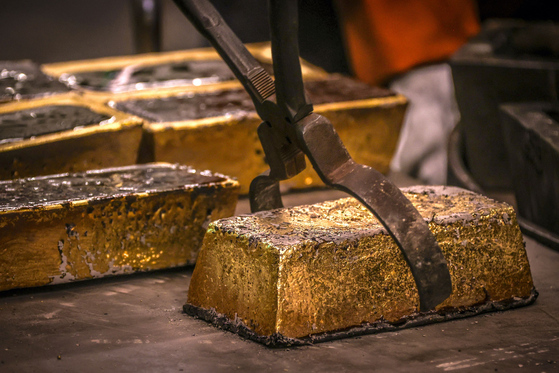Will the high-altitude march of gold, which has continued for more than two years, end? The prices of various raw materials, such as oil and copper, are beating horribly, but gold alone seems to have faded. The title of a representative inflation (increased inflation) defense asset is also on the verge. It is also far from bitcoin’s wide move, called’digital gold’.
On the 17th (local time) on the New York Merchandise Exchange, gold futures prices ended at $1772.8 per ounce. It is the lowest since June 19 last year. This is a 16.7% drop from the last August high ($2069.4 per ounce), and 6.5% this year. It is different from the atmosphere when global investment banks (IBs) fired up the bullish theory of gold prices only six months ago, saying, “The age of 3000 dollars is coming.

Gold bars are made at a foundry in Sydney, Australia. AFP=Yonhap News
Is gold, an inflation hedge asset? 6.5% this year
Gold prices are strong when there are prey such as’crisis’ and’inflation’. The strength of gold, which started at the $1,200 per ounce level in September 2018, has been amplified after the US-China trade conflict and concerns about a global economic slowdown. Last year, gold prices surged due to anxiety about the novel coronavirus infection (Corona 19).
While gold was highlighted as a’safe asset’ until the first half of last year, inflation hedge (risk diversification) demand raised prices in the second half of last year. This is the impact of the US’s powerful’money release’ as a countermeasure for Corona 19. At that time, expectations for gold prices to rise as the possibility of inflation this year increased, but gold prices are on the contrary.
There are many reasons why the price of gold is unreal. First of all, the US Treasury bond rate is rising. The US 10-year Treasury bond rate, which hit a historic low (0.51%) in August last year, rose to 1.33% during the day. This is the result of the combination of the Corona 19 vaccine supply and the economic recovery expectations. As gold is an interest-free asset, it has a relatively lower attractiveness when interest rates rise.
Due to concerns over rising government bond yields and tapering
The second factor is the possibility of reducing (tapering) quantitative easing in the US. The Federal Reserve’s (Fed) action, which has increased the amount of money “abnormal” to prevent the economic slowdown caused by Corona 19, fueled concerns about inflation and led the gold price to rise.
However, when vaccination begins and inflation occurs due to economic recovery and liquidity expansion, concerns are raising that the United States may tighten money. Fed chairman Jerome Powell said, “Tapering is premature,” but the market is increasingly wary. This means gold’s position as an inflation defense asset has declined.
Bitcoin’s emergence as a substitute for gold also played a part. Bitcoin is called’digital gold’ due to its limited amount of issuance, and is considered another’inflation hedge’. This is because it will defend against the decline in the value of money. JPMorgan said, “Bitcoin has emerged as a gold competitor.”
Institutional investors are flocking, and bitcoin has recently hit $52,000. Choi Jin-young, a researcher at Ebest Investment & Securities, said, “Money is escaping from the Global Gold Listed Index Fund (ETF) and the inflow of funds to Bitcoin-related funds is increasing.”

Is the bull market coming down? Graphic = Younghee Kim [email protected]
“Under $1800”
The market’s interest is the future of gold prices. Morgan Stanley predicted that “by the end of this year, gold will be below $1,800 per ounce.” Although inflation is expected this year, it is expected to slightly exceed 2% over the next two years. It means that there will be no inflation strong enough to boost gold prices.
There is also an objection. As gold does not have interest, it moves in the opposite direction of the real interest rate (nominal interest rate-expected inflation). The logic is that even if the government bond yield, the nominal interest rate, rises a little further, the real interest rate will retreat as prices rise and the gold price will rise.
Hwang Byeong-jin, a researcher at NH Investment & Securities, said, “The base effect of the corona 19-induced oil price plunge in March of last year could lead to a sharp rise in inflation expectations for March and April.” I can.”
There is also an expectation that the gold price may regain momentum if the inflationary rise due to the rise in oil prices sharpens. On the same day, in March, Western Texas crude oil (WTI) for delivery was traded at $61.14 per barrel, a record high in one year and one month. Kyu-yeon Jeon, a researcher at Hana Financial Investment, said, “Even if you look at oil prices alone, there is a high possibility that US consumer prices will rise above 3%.”
Reporter Hwang Eui-young [email protected]
